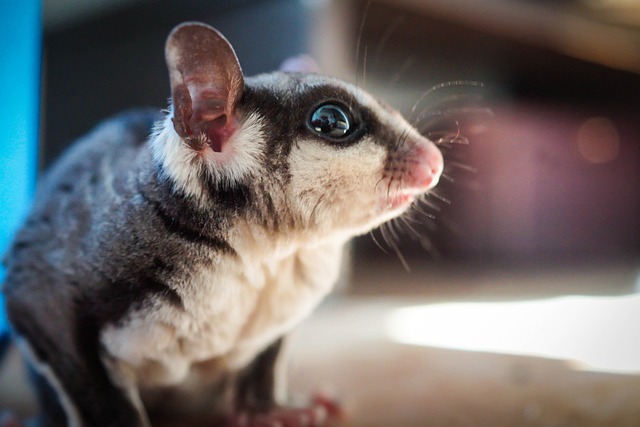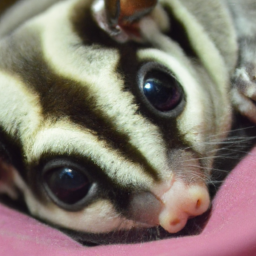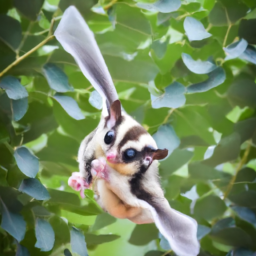How Hard Is It To Take Care Of A Sugar Glider
Are you curious about how difficult it is to take care of a sugar glider? Well, in this article, you’ll learn all about the responsibilities and challenges that come with owning these adorable marsupials as pets. From their specialized diet and unique housing requirements to their social needs and necessary veterinary care, you’ll gain a better understanding of what it takes to provide a happy and healthy home for a sugar glider.
Taking care of a sugar glider may seem daunting at first, but with proper knowledge and preparation, it can be a rewarding and enjoyable experience. One of the key aspects of their care is providing a balanced and nutritious diet that consists of a variety of fresh fruits, vegetables, and a specially formulated sugar glider diet. Additionally, their housing should be spacious, with plenty of climbing opportunities and places to hide. Socialization and mental stimulation are also crucial, as sugar gliders are highly sociable animals that thrive in the company of their own kind. Regular veterinary check-ups and providing a safe environment are also essential to ensure their overall well-being.

How Hard Is It To Take Care Of A Sugar Glider?
Taking care of a sugar glider as a pet can be a rewarding and enjoyable experience. These small, nocturnal creatures are known for their adorable appearance and playful nature. However, before adding a sugar glider to your family, it is essential to understand the level of care and commitment required to ensure their well-being. In this article, we will explore the basics of providing proper care for sugar gliders, including their habitat, nutrition, healthcare, grooming, exercise, training, and traveling needs.
Basic Information
Natural Habitat of Sugar Gliders
Sugar gliders are native to Australia and Indonesia, where they inhabit forests and woodlands. In the wild, they live in large groups called colonies and spend most of their lives in trees. These arboreal animals have a natural ability to glide through the air, using a patagium, a thin membrane stretching from their wrists to their ankles. It is essential to consider their natural habitat when creating a suitable environment for them in captivity.
Physical Characteristics of Sugar Gliders
Sugar gliders have several unique physical characteristics that make them fascinating creatures. They have a small, compact body, measuring around 5 to 6 inches in length, excluding their tail, which adds an additional 6 to 7 inches. Their fur is soft and thick, with a range of colors from gray and silver to cream and brown. Their large, round eyes provide excellent night vision, while their long, slender tail helps them maintain balance while gliding.

Housing and Enclosure
Choosing the Right Cage
When selecting a cage for your sugar glider, it is crucial to choose one that provides ample space for them to climb and glide. A cage with horizontal bars and multiple levels is ideal, as it allows them to exercise and explore. The minimum recommended cage size for a pair of sugar gliders is 24 inches long, 24 inches wide, and 36 inches tall. The spacing between the bars should be no more than half an inch to prevent the gliders from escaping.
Creating a Suitable Environment
Inside the cage, it is essential to create a stimulating and comfortable environment for your sugar gliders. Provide them with branches, ropes, and ladders for climbing, as well as a variety of toys and enrichment activities to keep them mentally stimulated. Line the bottom of the cage with a safe bedding material, such as shredded paper or aspen wood shavings, to absorb urine and provide a comfortable resting area.
Importance of Proper Ventilation
Ensuring proper ventilation in the sugar glider’s enclosure is crucial for their respiratory health. Adequate air circulation helps prevent the buildup of ammonia from their waste, which can be harmful to their delicate lungs. Positioning the cage in an area with good airflow and avoiding overcrowding can help maintain a healthy environment for your sugar gliders.
Feeding and Nutrition
Understanding Dietary Needs
Proper nutrition plays a vital role in the health and well-being of sugar gliders. In the wild, they feed on a diet consisting primarily of nectar, tree sap, pollen, insects, and the occasional fruit. As a pet owner, it is essential to replicate their natural diet as closely as possible. A sugar glider’s diet should primarily consist of a commercially produced pellet formulated specifically for sugar gliders.
Providing a Balanced Diet
In addition to the pellet, it is essential to provide a variety of fresh fruits, vegetables, and insects as part of their diet. Fruits such as apples, grapes, and bananas, and vegetables like carrots, sweet potatoes, and leafy greens, should be offered in small quantities. Insects such as mealworms and crickets can be given as occasional treats to satisfy their natural foraging instincts.
Supplementing with Fresh Fruits and Vegetables
Supplementation with fresh fruits and vegetables is essential to ensure a well-rounded diet for sugar gliders. These foods provide essential vitamins and minerals that may be lacking in the pellet diet alone. However, it is important to remember that sugar gliders have specific dietary requirements, and certain fruits and vegetables, such as citrus fruits and onions, should be avoided as they can be harmful to their health.

Bonding and Socialization
Establishing Trust and Building a Relationship
Building trust and establishing a bond with your sugar gliders is a crucial aspect of their care. Since sugar gliders are social animals, it is recommended to keep them in pairs or small groups to prevent loneliness. Spend time interacting with your gliders regularly, speaking to them softly, and offering treats to encourage positive associations.
Handling and Interacting with Sugar Gliders
When handling sugar gliders, it is important to do it gently and with care. Support their body properly and avoid squeezing or applying any pressure on their delicate bones. Allow them to climb on your hand or shoulder at their own pace and avoid sudden movements that may startle them. Remember, sugar gliders are arboreal animals and have a natural instinct to climb, jump, and glide, so it is important to provide them with ample climbing opportunities outside of the cage.
Healthcare and Veterinary Care
Routine Check-ups and Vaccinations
Regular veterinary check-ups are crucial for the overall health and well-being of your sugar gliders. Find a veterinarian experienced in exotic pet care who can provide routine examinations, vaccinations, and dental care if necessary.
Common Health Issues
Sugar gliders are generally healthy animals, but they are prone to certain health issues. Obesity, dental problems, and bacterial infections are some of the common health concerns to watch out for. It is important to monitor their weight, provide regular dental care, and maintain good hygiene in their living space to prevent these issues.
Emergency Care and First Aid
Having a basic understanding of first aid for sugar gliders can be essential in case of emergencies. Always keep a pet first aid kit on hand and know the nearest emergency veterinary hospital that can provide care for exotic animals.
Grooming and Hygiene
Bathing and Nail Trimming
Sugar gliders are naturally clean animals and do not require regular baths. However, if your glider becomes soiled, you can use a damp cloth to gently wipe them down. Nail trimming is an essential aspect of grooming for sugar gliders, as long nails can cause discomfort and may get caught on objects. Use a small pet nail trimmer and be cautious not to cut into the quick of the nail.
Maintaining Cleanliness in the Living Space
Maintaining cleanliness in the sugar glider’s living space is important to prevent the buildup of bacteria and odors. Regularly clean the cage, removing any soiled bedding, and disinfecting the surfaces. Avoid using strong chemicals or cleaners that may be toxic to sugar gliders.
Exercise and Stimulation
Providing Ample Playtime
Sugar gliders are active animals and require daily exercise and stimulation. Provide them with plenty of out-of-cage playtime in a safe, glider-proofed area. Create a designated play area with glider-safe toys, branches, and tunnels to encourage physical activity and mental stimulation.
Toys and Enrichment Activities
Offering a variety of toys and enrichment activities is essential to keep sugar gliders engaged and entertained. Toys such as ropes, tunnels, and puzzle feeders can provide mental stimulation and mimic their natural foraging behaviors.
Training and Behavior
House Training and Litter Box Training
Sugar gliders can be trained to use a litter box, which can help maintain cleanliness in their living space. Place a small litter box in one corner of their cage and gradually introduce them to it by placing their waste in the box. Reward them with treats and praise when they use the litter box.
Understanding Sugar Glider Behavior
Understanding sugar glider behavior is crucial for their care and well-being. They are highly social animals and communicate through various vocalizations, body language, and scent marking. Learning to interpret their behavior can help you understand their needs and provide appropriate care.
Traveling with Sugar Gliders
Preparing for Travel
When traveling with sugar gliders, it is important to plan and prepare in advance. Provide a secure and comfortable travel enclosure with familiar bedding and toys. Ensure that the travel enclosure is properly ventilated and secure to prevent any escapes.
Transportation Tips and Considerations
During travel, it is important to keep the sugar gliders’ stress levels to a minimum. Avoid exposing them to extreme temperatures or loud noises. Plan for frequent breaks to allow them to stretch their legs and provide fresh water and food if necessary.
How Regular Vet Visits Affect the Care of a Sugar Glider?
Regular sugar glider vet visits are crucial for their overall health and well-being. These visits allow the vet to monitor the sugar glider’s condition, provide necessary vaccinations, and detect any potential health issues early on. By scheduling regular sugar glider vet visits, owners can ensure that their pets receive proper care and attention.
Does A Sugar Glider’s Ability to Go Without Food Affect the Difficulty of Caring for Them?
The sugar glider food deprivation timeline can affect the difficulty of caring for them. While they can go without food for up to 24 hours, prolonged periods can lead to health issues. Proper diet and feeding schedules are crucial for maintaining their well-being and ease of care.
Conclusion
Taking care of a sugar glider involves a significant commitment of time, effort, and resources. However, with the right knowledge and dedication, providing proper care for these adorable creatures can be a fulfilling experience. By understanding their natural habitat, providing a suitable environment, ensuring a balanced diet, bonding and socializing, prioritizing healthcare, grooming and hygiene, encouraging exercise and stimulation, training and behavior management, and effectively traveling with them, you can ensure a happy and healthy life for your sugar glider.




